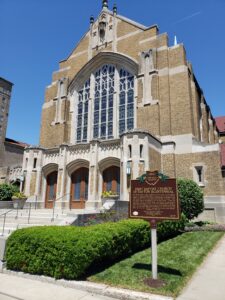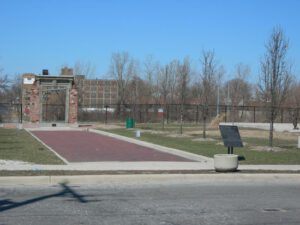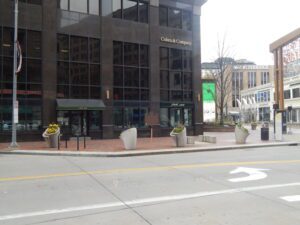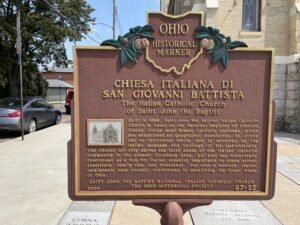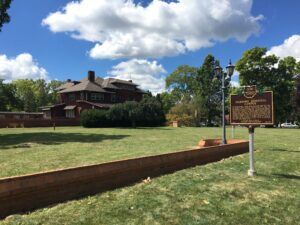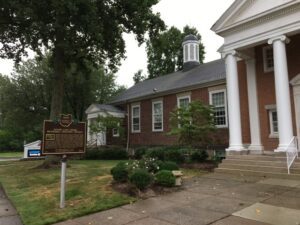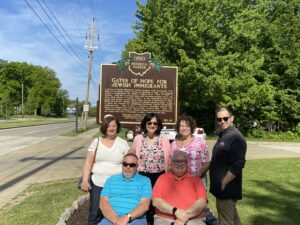, OH
First Baptist Church of Dayton organized on May 29, 1824. A council met on the porch of William Huffman’s home at Third and Jefferson and approved 9 members as a congregation. The next day Lydia Huffman was baptized in the Great Miami River, the first recorded Baptist immersion in the city. Their first church building was erected in 1827 on Main Street. In 1829 the congregation suffered a Campbellite schism. Those resolved to remain Baptist incorporated on February 25, 1837, as The First Regular Baptist Church of Dayton, Ohio. The foundations for the Monument Avenue building were begun prior to the 1913 Dayton flood and the cornerstone was laid May 31, 1914. The building was completed, furnished, and ready for worship on June 26, 1915. (Continued on other side)
, OH
In 1934, workers at the Electric Auto-Lite Company and other automotive-related manufacturers secretly organized the Automobile Workers Federal Union Local 18384, American Federation of Labor (AFL), which became the United Auto Workers (UAW) Local 12. Anti-unionism, broken pledges by management, and abuse of workers had festered locally for generations. Workers bitterly resented the fact that management took advantage of the Depression’s high unemployment to decrease wages. In February, workers struck at Auto-Lite, Bingham Stamping, Logan Gear, and Spicer Manufacturing Company. When management refused to negotiate in good faith, the workers, including a large number of women, struck the Auto-Lite in mid-April. Auto-Lite management secured a court order limiting the number of strikers to twenty-five. The strike appeared to be lost until the Lucas County Unemployed League organized fierce resistance to the court injunction as the crowd around the plant grew to ten thousand. (continued on other side)
, OH
ʻAbdu’l-Bahá (1844-1921) visited Cleveland on His historic journeys to Europe and North America to proclaim the message of His Father, Baháʼu’lláh, Prophet-Founder of the Baháʼí Faith. Together they suffered 40 years of imprisonment and exile, which began in Persia with their support of the Báb, Baháʼu’lláh’s forerunner. In 1912, following His release from prison in Palestine, ʻAbdu’l-Bahá toured many American cities as Baháʼu’lláh’s designated successor. He spoke in Cleveland on May 6th and 7th, at the former Hotel Euclid and other sites, sharing this message: “The oneness of humankind will be a fact. The various religions shall be united, and the various races shall be known as one kind. The Orient and the Occident shall be united and the banner of international peace shall be unfurled. The world shall find peace and the equality and rights of men shall be established.” Since His visit, the Baháʼí Faith has gained millions of followers, and it has been established in most countries and territories of the world.
, OH
The National Italian Catholic parish of Saint John the Baptist was founded in October 1896 by the Reverend Father Alexander Cestelli, D.D. Father Cestelli was born in Fiesole, Italy and came to America in 1888 to serve as a professor at St. Paul’s Seminary in Minnesota. In January 1896, founding Rector Monsignor John Joseph Jessing invited Father Cestelli to serve at the Pontifical College Josephinum in Columbus, Ohio as a professor of moral theology. In October 1896, the Right Reverend John Ambrose Watterson, D.D., Bishop of Columbus, appointed Father Cestelli as pastor of the Italian Catholic community. Sunday Mass was celebrated in the baptistery of Saint Joseph Cathedral until September 18, 1898, when the Most Reverend Sebastiano Martinelli, Apostolic Delegate to the United States, dedicated this historic church.
, OH
The Harding Hospital, initially called the Columbus Rural Rest Home, was founded in 1916 by George T. Harding II, MD (1878-1934) and his associates, many of whom shared his commitment to service and his Seventh-day Adventist Christian faith. The psychiatic treatment center moved to Worthington in 1920. The hospital’s goal was to provide treatment with attention to the person’s physical, mental, social and spiritual needs. The program, with its emphasis on relational issues and psychotherapy, drew patients from across Ohio and beyond. In 1936 a residency program in psychiatry for physicians was started and educational programs for other mental health professionals followed. The campus’ beauty contributed to its being a place of healing for many. Since 1999, Harding Hospital has been a part of The Ohio State University’s Wexner Medical Center.
, OH
Elizabeth Tyron Sadler started the Methodist Episcopal Church in North Dover Township in June 1827, on land owned by her father-in-law Christopher Sadler. Charter members were the Rev. Eliphalet and Mrs. Margaret Johnson and their daughter Rebecca, along with niece Catherine Porter Foote. Elizabeth and William Sadler donated the land and much of the material needed to build a new wood-frame church here in 1841. The still-growing congregation built a brick church in 1908 and added a new sanctuary in 1955. Taking the name Bay United Methodist Church in 1968, the church has remained a center of community life and faith continuously since 1827. Family names associated with the church’s early decades include Aldrich, Cahoon, Drake, Foote, Osborn, Powell, Sadler, Tuttle, and Wolf.
, OH
A group of Jewish immigrants fleeing Germany after Kristallnacht (The Night of the Broken Glass) settled in Cleveland in 1940. The refugees formed a congregation and named it Shaarey Tikvah, “Gates of Hope” in Hebrew. They met in private homes until obtaining premises above the Tasty Shop Bakery on Euclid Avenue. As the congregation thrived it moved and merged several times before settling in Beachwood in 1986. Rabbi Jacob Shtull, Shaarey Tikvah’s first English-speaking Rabbi, sought to honor the founders by establishing Cleveland’s annual Kristallnacht commemoration. “Face to Face,” a Holocaust education program that shares the refugee story with local schools, began in 1994. Today, this “Small Shul. Large Community” remains a tribute to the German immigrants that found their way to Cleveland to unite in friendship and faith.


